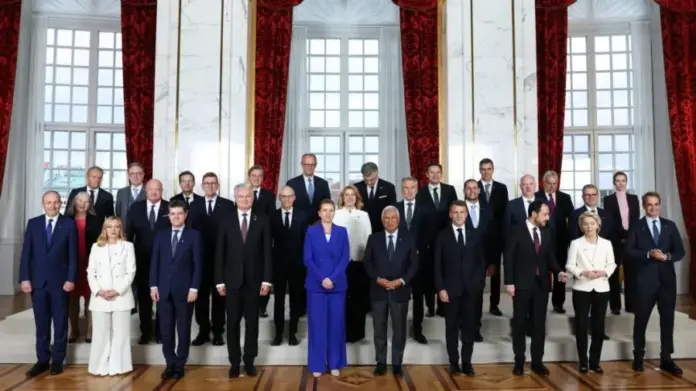At the conference “Enlargement Report 2025: Progress and Future Priorities of the Republic of Moldova,” held in Chisinau on November 11, 2025, during the “Foreign Relations (Cluster VI)” panel, Andrei Curararu, a public policy and security expert from the WatchDog.MD Community analyzed Moldova’s neutrality and its dependence on the European security architecture, particularly on NATO allies. He explained opportunities for military cooperation and outlined a strategic framework for the country’s integration into Europe’s collective defense system, such as Eastern Flank Watch, also known as the Drone Wall.
The EU and NATO launched “Eastern Flank Watch” to protect Europe’s eastern flank, where the Republic of Moldova is located, from threats like airspace violations. The project builds an air defense system against drones, or a “drone wall,” based on lessons learned from Ukraine.
Andrei Curararu analyzed the security architecture, the vulnerabilities of neutrality, and ways for Chisinau to align with European defense initiatives. “Drone incidents highlight ongoing security risks not only for EU member states but also for candidate and neutral states like the Republic of Moldova. This brings us to the ‘elephant in the room’: Moldova’s neutrality, without cooperation, becomes a vulnerability. We don’t have the capacity to fund all the necessary initiatives from our national budget, nor do we have a modernized security architecture capable of addressing new challenges. That’s why we must fully benefit from what’s happening within the EU, which now views defense and security as a key priority. In the coming years, Europe will spend five times more on security and defense — over €130 billion,” he explained.
He emphasized that neutrality without cooperation creates weakness and described how Moldova can transform reforms and cooperation with the EU and NATO into practical measures to strengthen national security: “First of all, we should continue participating in the European Peace Facility to show our intent to engage as a neutral state. We should invest in air defense, engineering defense, and participation in international missions. Moldova also benefits from a civil mission that strengthens cybersecurity, which proved crucial during recent elections. We witnessed billions of cyberattacks on our infrastructure during the electoral period — and we must expect these to continue in the next decade. When we talk about Eastern Flank Watch, we’re referring to a complex monitoring mechanism that Moldova could join. We are currently in a gray monitoring zone — between Ukraine, which increased its defense capacities, and Romania, a NATO member with expanded capabilities. Investments in acoustic, visual, and drone-interception sensors over Moldovan territory fully align with our candidate status.”
“The third direction on this roadmap that we absolutely must talk about involves one of the major investments the European Union will make — in dual-use infrastructure, meaning everything related to bridges, roads, and transport routes. Our Ministry of Defense should take an active role and consider how to align with the goals of European integration by building capacity and modernizing the national armed forces. It should also think creatively about how to use these funds — for example, to invest in bridges over the Prut River, in disaster-response infrastructure, and in counter-disinformation capabilities. A clear necessity is to join the European Military Semester, which helps plan purchases and identify capability gaps. The Republic of Moldova, making purchases on its own, will never receive the same offers as the European Union at scale. We must understand that every interaction with the European Union in the military field strengthens the neutrality of the Republic of Moldova. Neutrality declared on Telegram channels, with absurd ideas like ‘economic neutrality,’ does not strengthen Moldova — it weakens it,” Andrei Curararu also pointed out.
The roadmap for maintaining peace envisions that by 2027, Europe will establish a single military mobility area with harmonized rules and a network of land, air, and sea routes that enable the rapid movement of troops and equipment across the continent. This project, developed in close coordination with NATO, strengthens Europe’s ability to respond swiftly to any crisis.
What exactly does Eastern Flank Watch mean? Eastern Flank Watch establishes a shared defense capability — a “drone wall” — designed to detect and neutralize drones, especially those violating the airspace of member states. The initiative strengthens security across Eastern Europe, a region facing growing threats, including from Russian drones. It forms part of the EU’s broader defense strategy, complementing initiatives such as the European Air Shield and the European Space Shield. The project relies on close cooperation between EU member states on the eastern flank and NATO, integrating modern technologies and applying lessons learned from the war in Ukraine to build efficient, scalable, and cost-effective defense systems.
Since the start of the war in Ukraine, Russia has repeatedly violated the airspace of Moldova, as well as Romania, Poland, Bulgaria, Estonia, Lithuania, and Latvia, using drones. Until recently, officials interpreted these incidents as unintentional, but the recent drone incursion into Poland this autumn was deliberate and premeditated, signaling an escalation that Europe must address collectively.



